
How to Pack Your Calendar with High Paying Clients: 5 Game-Changing Strategies
As a coach or consultant, do you struggle to fill your calendar with high-paying clients who value your expertise?
You're not alone…
Getting clients is the #1 challenge that I hear almost every day.
Attracting the right clients can feel overwhelming, but there's a way to do it systematically so that you’re effectively leveraging both your time AND your money.
Introducing five game-changing strategies that will help you thrive in your coaching or consulting business… these proven techniques will have your calendar packed with eager, high-paying clients in no time.
Ready to transform your business?
Let's dive in.
Strategy 1: How You Can Use Social Media to Connect With Your Ideal Clients
Choose the right platforms for your target audience
You know social media is crucial for attracting high-paying clients, but where to start? Don't worry; we've got you covered.
First, research the demographics of each platform. Are your ideal clients hanging out on LinkedIn or Instagram? Maybe they're more into Facebook or Twitter.
The key is to find where your target clients spend their time online.
For example, let's say you're a career coach targeting mid-level professionals. You might find that LinkedIn is the perfect platform to connect with your audience, given its professional focus.
Optimize your social media profiles
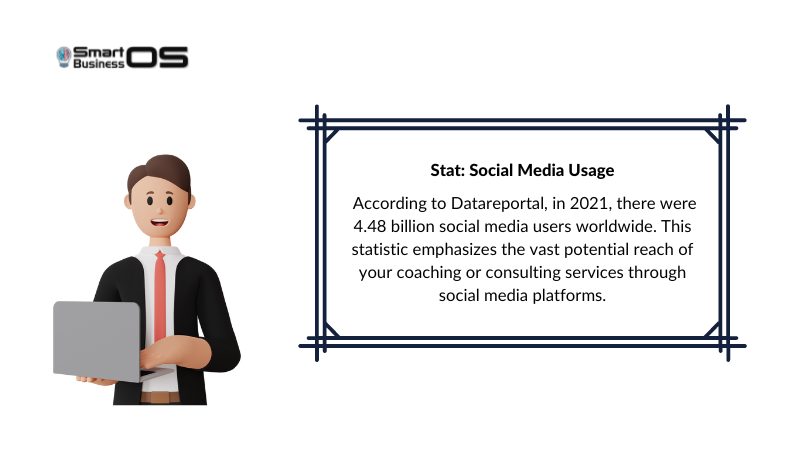
Now that you've found the right platform, it's time to make a killer first impression. Start by creating a professional and consistent brand image.
Use high-quality photos, a catchy tagline, and a coherent color scheme to showcase your expertise and unique value proposition.
Think about what sets you apart from other coaches or consultants in your field.
Are you a master at helping people pivot careers? Or maybe you're the go-to expert for scaling businesses.
Whatever it is, highlight it in your profile.
Share valuable content consistently
You've got their attention—now it's time to keep it. Create a content calendar and stick to it like glue. Share a mix of educational, engaging, and promotional content that resonates with your target audience. Remember, consistency is key.
For instance, let's say you're a marketing consultant.
You could share case studies, industry news, and quick tips to keep your audience informed and engaged. And don't forget to sprinkle in some promotional content, like testimonials or special offers, to remind them you're open for business.

Engage with your audience and build relationships
Social media isn't just about broadcasting—it's about connecting.
Respond to comments and messages, and join relevant groups or discussions to build genuine relationships with your target audience.
You never know where your next high-paying client could come from.
Actionable Example: Career Coach Utilizing LinkedIn for Client Attraction
Jane is a career coach who specializes in helping mid-level professionals transition to more fulfilling roles.
She decided to leverage LinkedIn as her primary social media platform due to its professional focus and the presence of her target audience. Here's how Jane successfully implemented Strategy 1 to attract high-paying clients:
1. Choose the right platform for your target audience
Jane conducted research on various social media platforms and discovered that her ideal clients – mid-level professionals seeking career growth – were most active on LinkedIn. This made it the perfect platform for her to connect and engage with her target audience.
2. Optimize your social media profile
Jane revamped her LinkedIn profile to showcase her expertise in career coaching. She used a high-quality, professional photo, crafted a catchy headline, and wrote a compelling summary that highlighted her unique value proposition. She also included keywords relevant to her niche, making it easier for potential clients to find her profile.
3. Share valuable content consistently
Jane created a content calendar to ensure she consistently shared engaging and educational content on her LinkedIn feed. She posted articles on career development, shared her clients' success stories, and offered tips on resume writing, interview preparation, and networking. Jane also engaged with her audience by asking questions and encouraging discussions in the comments section.
4. Engage with your audience and build relationships
In addition to posting content, Jane actively participated in LinkedIn Groups related to career development and joined conversations relevant to her expertise. She answered questions, offered advice, and connected with potential clients. Jane also made a point to respond to comments on her posts and messages in her inbox, building genuine relationships with her audience.
Case Study: Jane's Success Story
Within three months of implementing these organic social media strategies on LinkedIn, Jane saw a significant increase in engagement in her content and growth in her network.
As she consistently shared valuable content and built relationships, she started receiving inquiries from potential clients who were impressed with her expertise and insights.
By focusing on LinkedIn and following the steps outlined in Strategy 1, Jane successfully attracted six new high-paying clients in just three months, filling her calendar and boosting her coaching business.
This example demonstrates the power of leveraging free, organic social media strategies to attract the right clients and grow your coaching or consulting business.
Strategy 2: How You Can Create a Lead Magnet and Funnel that Speaks Directly to Your Target Audience's Needs and Desires
Develop a Relevant Lead Magnet
A lead magnet is an offer you make to potential clients in exchange for their contact information. To create a relevant lead magnet, think about your target audience's pain points, needs, and desires.
What kind of content would they find valuable
Personally I like to see something combatting your audience's #1 Challenge used. Consider formats like eBooks, checklists, templates, or webinars.
For example, if you're a productivity coach, you might create a lead magnet that offers a productivity checklist or a time management guide.
Design a Sales Page for Your Lead Magnet
A sales page is a landing page where you promote your lead magnet and encourage potential clients to opt in. A compelling sales page should highlight the benefits of your lead magnet and explain how it can solve your target audience's problems.
Use persuasive language, testimonials, and visuals to make your sales page stand out. Make it clear what your potential clients will get when they opt in and what they need to do to get it.
Create an Upsell on the Thank You Page
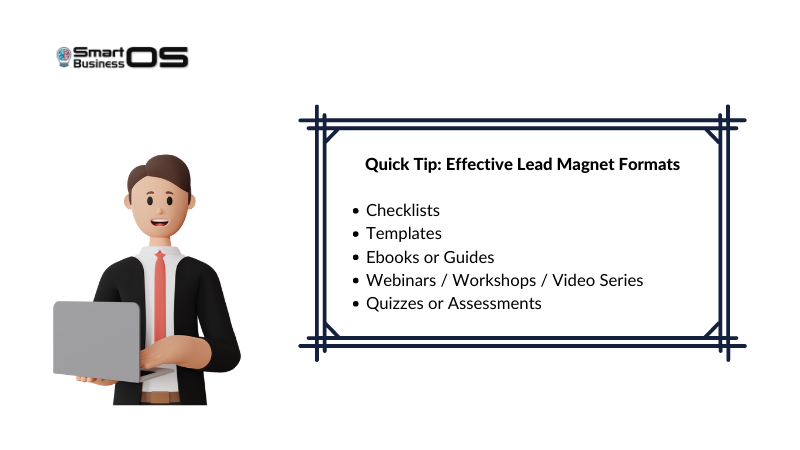
After someone opts in for your lead magnet, they'll land on a thank you page.
This is the perfect opportunity to offer an upsell, which is a complementary product or service that adds value to your lead magnet.
For example, if you're a health coach, you might offer a free meal planning template as your lead magnet, and on the thank you page, you could upsell a 1:1 coaching call to discuss their personalized meal plan.
Include an Upsell in Your Lead Magnet
In addition to the thank you page, you can also include an upsell within your lead magnet. This can be a soft sell, such as a call-to-action to book a free strategy call or a discounted offer for a complementary product or service.
For example, if you're a copywriter, you might create a lead magnet that offers a copywriting checklist, and within the lead magnet, you could include an upsell for a discounted website copywriting package or - if you were a copywriting coach - an upsell for a free strategy call.
Offer a Free Strategy Call
The final step in your funnel is to offer a free strategy call. This is your chance to build a relationship with your potential clients, understand their needs and goals, and offer your services as a solution.
During the strategy call, ask open-ended questions to gather information, listen actively, and provide valuable advice. Focus on building trust and rapport with your potential clients, rather than pushing for a sale.
For example, if you're a business coach, you might offer a free strategy call to help potential clients identify their business goals and challenges, and provide actionable advice to get them started. Then - if you see there may be a fit - you open the conversation up to see if they'd be open to hearing how you are able to assist them further.
By creating a relevant funnel, you can attract potential clients, build trust and rapport, and convert them into high-paying clients who see the value in your services.
Actionable Example: Life Coach Creating a Lead Magnet and Funnel
Emily is a life coach specializing in helping individuals find their purpose and live a fulfilling life. To attract high-quality leads and convert them into clients, she decides to implement Strategy 6: Creating a Lead Magnet and Funnel. Here's how Emily successfully implements this strategy:
1. Develop a Relevant Lead Magnet
Emily considers her target audience's needs and desires. She creates a lead magnet in the form of an eBook titled "Unlock Your Potential: A Guide to Discovering Your Life Purpose." This eBook offers practical exercises and insights to help individuals gain clarity and find their life's purpose.
2. Design a Sales Page for the Lead Magnet
Emily creates a dedicated sales page on her website to promote the eBook. The sales page highlights the benefits of the eBook, emphasizing how it can help individuals overcome confusion and find direction in their lives. She includes compelling testimonials from previous clients who have benefited from her coaching services.
3. Create an Upsell on the Thank You Page
After someone opts in to receive the eBook, they land on a thank you page. On this page, Emily offers an upsell—a limited-time discount for a personalized one-on-one coaching session. She explains how the coaching session can provide individualized guidance and support to help individuals make progress on their life purpose journey.
4. Include an Upsell in the Lead Magnet
Within the eBook itself, Emily includes an upsell to a group coaching program she offers. She includes a call-to-action inviting readers to join the program, emphasizing the benefits of group support and accountability in their pursuit of discovering and living their life purpose.
5. Offer a Free Strategy Call
As the final step in her funnel, Emily offers a free strategy call to potential clients. During the call, she engages in a conversation, actively listening to their aspirations, challenges, and goals. Emily provides valuable advice and demonstrates her expertise while building rapport and trust with the potential client.
Case Study: Emily's Success Story
By implementing this lead magnet and funnel strategy, Emily attracts a steady stream of leads interested in discovering their life purpose. Many individuals find value in her eBook and choose to explore further by taking advantage of the upsell offers. Emily successfully converts a significant portion of these leads into high-paying clients through the free strategy calls, where she personalizes her coaching services based on their specific needs and goals.
Within six months of implementing Strategy 6, Emily experiences a 50% increase in her client base and achieves a significant boost in revenue. This success demonstrates the power of creating a lead magnet and funnel that speaks directly to the target audience's needs and desires, guiding them towards transformation and becoming paying clients.
Strategy 3: Who Are Your Potential Partners in Your Industry, and How Can You Identify Them?
Identify potential partners within your industry
Two heads are better than one, right? So, why not team up with others in your industry to reach more high-paying clients?
Start by identifying complementary businesses or professionals who share your target audience but aren't direct competitors. Consider the benefits of partnering for both parties—think of win-win situations.
For example, if you're a sales coach, you might partner with a marketing agency. Their clients need help closing deals, and your clients could benefit from improved marketing strategies.
Reach out to potential partners with a tailored proposal
Once you've identified potential partners, it's time to make your move. Reach out with a tailored proposal that explains your value proposition and how it aligns with their goals. Suggest specific ways you can collaborate to make it a no-brainer for them to say yes.
For instance, you could offer to guest blog on their website, co-host a webinar, or provide exclusive discounts for their clients.

Develop mutually beneficial partnerships
With your partners on board, it's time to make the most of your collaboration.
Host joint webinars or workshops, share referrals, or co-create content to reach new audiences and drive growth for both parties.
The key is to provide value for your partners and their clients, so everyone comes out ahead.
Actionable Example: Wellness Coach Establishing Strategic Partnerships
Laura is a wellness coach who specializes in helping busy professionals find balance and reduce stress through personalized wellness plans. To expand her reach and attract high-paying clients, she decided to establish strategic partnerships with complementary businesses. Here's how Laura successfully implemented Strategy 3:
1. Identify potential partners within your industry
Laura began by identifying complementary businesses or professionals who shared her target audience but weren't direct competitors. She created a list of potential partners, including yoga studios, nutritionists, and fitness trainers, who could benefit from offering their clients a holistic wellness approach.
2. Reach out to potential partners with a tailored proposal
With her list of potential partners in hand, Laura crafted tailored proposals for each business, explaining her value proposition and how it aligned with their goals. She suggested specific ways they could collaborate, such as co-hosting workshops, sharing referrals, or offering exclusive discounts for each other's clients.
3. Develop mutually beneficial partnerships
After reaching out to her potential partners, Laura successfully established partnerships with a local yoga studio and a nutritionist. They collaborated on a series of workshops that combined yoga, nutrition, and stress management techniques, reaching new audiences and providing value for their clients.
Case Study: Laura's Success Story
By establishing strategic partnerships, Laura was able to reach a larger audience and showcase her expertise in wellness coaching to a new group of potential clients. The workshops she co-hosted with her partners were well-received, and several attendees expressed interest in her coaching services.
Within four months of implementing Strategy 3, Laura secured five new high-paying clients who were referred to her by her partners or who attended the collaborative workshops.
This success demonstrates the power of establishing strategic partnerships to expand your reach, attract the right clients, and grow your coaching or consulting business.
Strategy 4: How You Can Use Discovery Calls to Build Trust and Demonstrate Value to Potential Clients
Set up a scheduling system for appointments
You know the saying, "The proof is in the pudding"? Well, one of the best ways to show potential clients you're the real deal is by offering free discovery calls or consultations.
Start by choosing an online booking platform, like Calendly or Acuity, and designate your availability and appointment types.
Promote your free discovery calls or consultations
Now that your scheduling system is in place, it's time to spread the word.
Share your availability on social media and your website, and encourage current clients to refer friends or colleagues.
You might even consider offering incentives, like discounted services, for successful referrals.
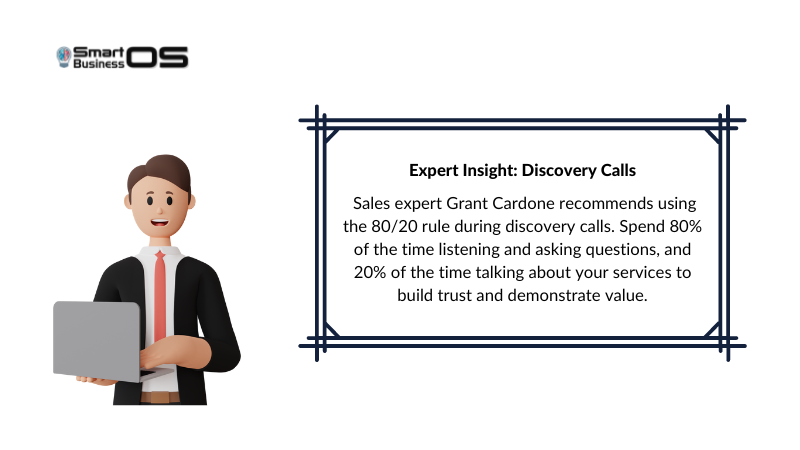
Use discovery calls to build trust and demonstrate value
During your discovery calls, focus on building trust and demonstrating value.
Ask questions to understand the client's needs, then provide actionable advice and showcase your expertise.
This is your chance to give them a taste of what working with you is like, so make it count!
For example, let's say you're a leadership coach, and a potential client is struggling with team communication.
Offer some practical tips for improving communication and explain how your coaching program could help them take their team to the next level.
Actionable Example: Career Coach Offering Free Discovery Calls
Daniel is a career coach who specializes in helping recent graduates and young professionals find their ideal career path and secure their dream job.
To attract high-paying clients, he decided to offer free discovery calls to showcase his expertise and give potential clients a taste of his coaching style. Here's how Daniel successfully implemented Strategy 4:
1. Set up a scheduling system for appointments
Daniel started by choosing an online booking platform, like Calendly, and designated his availability for free 30-minute discovery calls. He set up appointment types specifically for these calls to ensure potential clients could easily book a time with him.
2. Promote your free discovery calls or consultations
To spread the word about his free discovery calls, Daniel shared his availability on his website, social media profiles, and in his email newsletter. He encouraged current clients to refer friends or colleagues who might be interested in career coaching and offered a discount on future coaching sessions for successful referrals.
3. Use discovery calls to build trust and demonstrate value
During the discovery calls, Daniel focused on building trust and demonstrating the value of his coaching services. He asked questions to understand the potential client's career goals and challenges, then provided personalized advice and showcased his expertise.
Case Study: Daniel's Success Story
By offering free discovery calls, Daniel was able to connect with potential clients, build trust, and demonstrate his expertise in career coaching.
Many of the people he spoke with were impressed with his personalized approach and the actionable advice he provided during the calls.
Within three months of implementing Strategy 4, Daniel converted 30% of his discovery calls into high-paying clients, with most clients signing up for multiple coaching sessions.
This success demonstrates the power of offering free discovery calls or consultations to build trust, showcase your expertise, and attract the right clients to grow your coaching or consulting business.
Strategy 5: How You Can Create Targeted Paid Ad Campaigns that Resonate with Your Ideal Clients and Prompt Them to Take Action
Choose the right advertising platform(s) for your target audience
Ready to put some money behind your marketing efforts? Start by choosing the right advertising platform(s) for your target audience. Consider demographics and user behavior, as well as your budget and goals, to make an informed decision.
For example, if you're a life coach targeting young professionals, Instagram or Facebook Ads might be the perfect fit for your advertising efforts.
Create targeted ad campaigns
With the right platform(s) in mind, it's time to create targeted ad campaigns that speak directly to your ideal clients. Develop compelling ad copy and visuals that showcase your value proposition and grab their attention. Use targeting options, like interests, demographics, or behaviors, to ensure your ads reach the right people.
For instance, if you're a financial consultant, you could create ads that highlight your expertise in helping clients save money and invest wisely, targeting individuals who have shown interest in personal finance or investment topics.
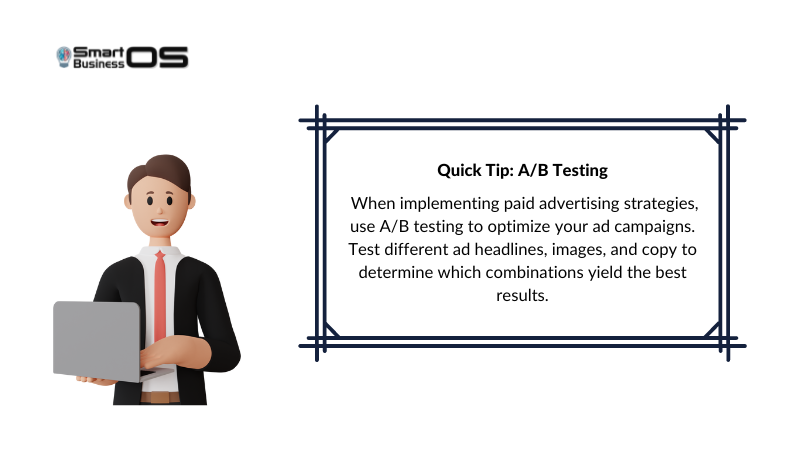
Monitor and optimize your ad performance
Finally, don't just set and forget your ads.
Track key performance indicators (KPIs), like click-through rates, conversion rates, or cost per acquisition, to measure the effectiveness of your campaigns.
Adjust your campaigns based on data and insights to continually improve your results and maximize your return on investment (ROI).
For example, if you notice that your ads are getting lots of clicks but few conversions, you might want to tweak your landing page or your ad copy to better align with your target audience's expectations and needs.
Remember, optimizing your ad performance is an ongoing process—keep testing and learning to get the most bang for your buck.
Actionable Example: Business Coach Implementing Paid Advertising Strategies
Sophia is a business coach who specializes in helping small business owners improve their operations, increase profits, and scale their companies. To attract high-paying clients, she decided to implement paid advertising strategies to reach a larger audience and showcase her services. Here's how Sophia successfully implemented Strategy 5:
1. Choose the right advertising platform(s) for your target audience
Sophia started by researching different advertising platforms, including Google Ads, Facebook Ads, and LinkedIn Ads. Considering her target audience of small business owners, she decided that Facebook Ads and LinkedIn Ads would be the most effective platforms to reach her ideal clients.
2. Create targeted ad campaigns
With the chosen platforms in mind, Sophia created targeted ad campaigns that spoke directly to small business owners. She developed compelling ad copy and visuals that showcased her value proposition and expertise in business coaching. Using targeting options like job titles, company size, and interests, she ensured her ads reached the right audience.
3. Monitor and optimize your ad performance
Sophia regularly monitored the performance of her ad campaigns, tracking key performance indicators (KPIs) like click-through rates, conversion rates, and cost per acquisition. She analyzed the data to identify areas for improvement and adjusted her campaigns accordingly.
Case Study: Sophia's Success Story
By implementing paid advertising strategies, Sophia was able to reach a larger audience of potential clients and showcase her expertise in business coaching.
Her targeted ad campaigns resonated with small business owners, resulting in an increase in website traffic, discovery call bookings, and ultimately, new high-paying clients.
Within six months of implementing Strategy 5, Sophia doubled her client base and increased her monthly revenue by 80%.
This success demonstrates the power of using paid advertising strategies to attract the right clients and grow your coaching or consulting business.
**Bonus Strategy 6: What Makes Your Services Unique Compared to Your Competitors?
Identify your unique selling points
Before you can sell your services to others, you need to know what makes you stand out. Start by assessing your skills, experience, and expertise. Then, take a look at your competitors and figure out what sets you apart.
For example, let's say you're a health coach. You might have a unique approach to weight loss that combines nutrition, mindfulness, and fitness. That's your unique selling point!
Craft a clear and concise value proposition statement
Now that you know what sets you apart, it's time to put it into words. Craft a clear and concise value proposition statement that explains the benefits your clients can expect.
Use language that resonates with your target audience—this is your chance to make them see you as the solution to their problems.
For instance, if you're a business consultant, your value proposition might be something like, "I help startups skyrocket their revenue by implementing proven growth strategies."
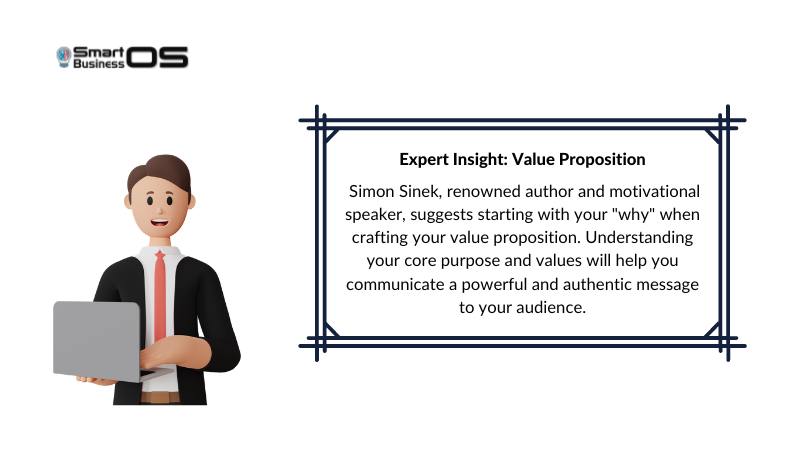
Incorporate your value proposition across your marketing channels
With your value proposition in hand, it's time to shout it from the rooftops.
Update your website, social media profiles, and email signature to reflect your unique selling points.
Include your value proposition in your marketing materials, like brochures, business cards, and presentations, so your message is consistent and clear.
Actionable Example: Business Consultant Crafting a Compelling Value Proposition
Michael is a business consultant who specializes in helping small businesses improve their operations and increase revenue. To attract high-paying clients, he decided to develop a compelling value proposition that effectively communicated the benefits of his services. Here's how Michael successfully implemented Strategy 2:
1. Identify your unique selling points
Michael started by assessing his skills, experience, and expertise in business consulting. He analyzed his competitors to understand what set him apart from other consultants in the industry. He discovered that his unique selling point was his ability to streamline operations while reducing costs, which ultimately led to increased profitability for his clients.
2. Craft a clear and concise value proposition statement
Based on his unique selling point, Michael crafted a clear and concise value proposition statement: "I help small businesses increase profits by optimizing operations and cutting unnecessary costs." This statement effectively communicated the benefits his clients could expect from working with him.
3. Incorporate your value proposition across your marketing channels
With his value proposition in hand, Michael updated his website, social media profiles, and email signature to reflect his unique selling points. He incorporated the value proposition into his marketing materials, such as brochures, business cards, and presentations, ensuring a consistent and clear message.
Case Study: Michael's Success Story
After implementing Strategy 2, Michael noticed an increase in inquiries from potential clients who were intrigued by his value proposition.
As he consistently communicated his unique selling points across his marketing channels, he positioned himself as the go-to expert for small businesses seeking operational improvements and increased profits.
Within just two months of developing and promoting his value proposition, Michael attracted four new high-paying clients who were impressed with his expertise and the results he promised.
This success demonstrates the power of crafting a compelling value proposition to attract the right clients and grow your consulting business.
Your Fully Booked Future Awaits
It's time to stop spinning your wheels and start transforming your business with these five six game-changing strategies. Together, they'll build a solid foundation for a thriving practice filled with high-paying clients who value your expertise.
We know the journey may have its challenges, but with persistence, dedication, and marketing savvy, you'll see remarkable growth that makes it all worthwhile.
Don't wait another day—start implementing these strategies right now and watch your calendar fill up with eager clients.
And to further supercharge your success, book a FREE strategy call with me today to get personalized guidance tailored to your unique business needs.
It's time to show the world what you're truly capable of.
Are you ready to change lives, solve problems, and be a guiding light for your clients?
You CAN do this!!
To Your Success!
Derek
Let me offer you a COMPLIMENTARY
45-Minute Strategy Call
Let us work together to get CRYSTAL CLEAR on the #1 Challenge you're
currently facing and how to move past it!
© 2023 - Push and Pull Marketing, All Rights Reserved

